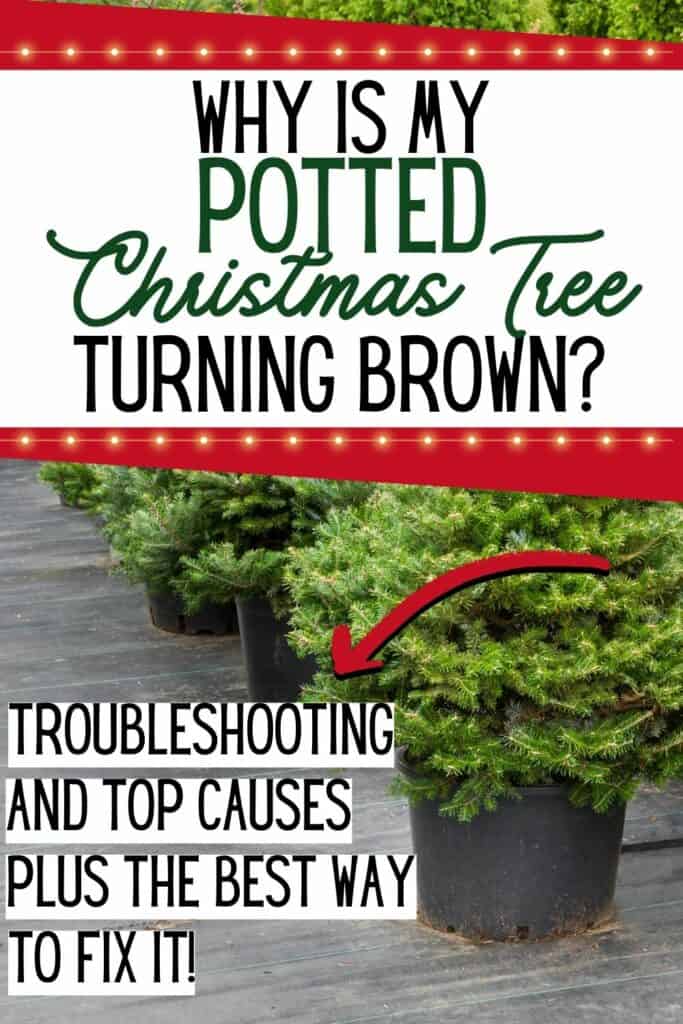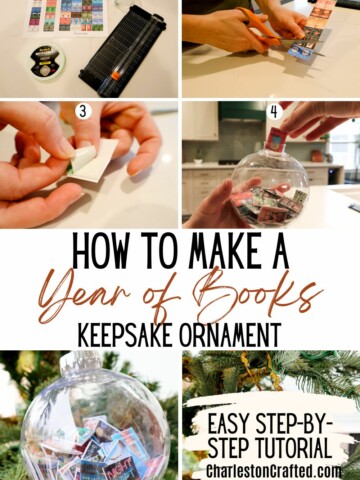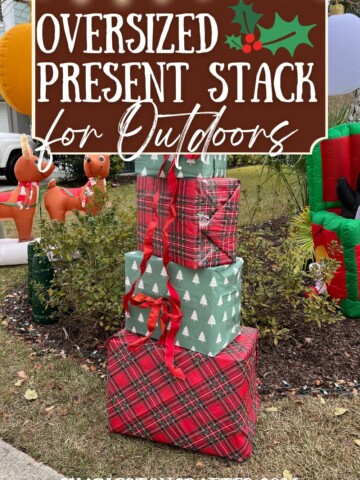Is your potted Christmas tree turning brown? Here are the top causes, what to do about it, and how to prevent your potted Christmas tree from turning brown!
Picking a Christmas tree is such a fun tradition. But, some people are a bit opposed to paying a ton of money for a dead tree.
And, I get that.
So, today I wanted to chat about potted Christmas trees, and specifically, why your potted Christmas tree is turning brown.
Because the point of a potted Christmas tree is that it won't die at the end of the season, right?!
You can check out our tips for how to fix a dried out Christmas tree (not potted) here!

Types of Potted Christmas Trees
It's important tot remember than many types of real Christmas tree that are sold look cute and small but grow into huge full grown trees.
If you plan on planting the tree in your yard, it is important to have the space for it and understand how big it will truly grown.
The most commonly sold types of potted Christmas trees include:
Dwarf Alberta Spruce (Picea glauca 'Conica')
This compact evergreen tree is a classic choice for holiday decorations. It's often sold as a pre-decorated miniature tree for both indoor and outdoor use.
After the holidays, it can be planted in the ground and gradually grows to a height of 10 to 13 feet.
Lemon Cypress (Cupressus macrocarpa 'Wilma')
Lemon cypress is another miniature potted tree that adds a touch of elegance to your holiday decor.
While it can be enjoyed indoors during the festivities, it's suitable for planting in large outdoor containers. Keep in mind that these trees may outgrow their pots over time.
Balsam Fir (Abies balsamea)
Known for its fragrant soft needles, the balsam fir thrives in colder climates with moderate summers (Zones 3-7).
When fully mature, it can reach an impressive height of 50 to 75 feet. Ensure you have enough outdoor space for this majestic tree.
Fraser Fir (Abies fraseri)
Similar to the balsam fir, the Fraser fir is a great choice for regions with slightly warmer summers (Zones 4-7).
It typically grows to a height of 30 to 50 feet and retains its delightful fragrance.
White Fir (Abies concolor)
White fir is well-suited for the Midwest and alpine West (Zones 4-9). It features an upright conical shape with soft, silvery needles.
At maturity, it can reach heights of up to 60 feet.
Douglas Fir (Pseudotsuga menziesii)
Despite its misleading name, the Douglas fir is a preferred choice for areas ranging from the Pacific Northwest down to the Southwest (Zones 4-8).
It boasts soft-tipped needles and can grow to a height of 40 to 80 feet.
White Pine (Pinus strobus)
Recognized for its long, soft needles, the white pine is a native pine species (Zones 3-8) often grown as a Christmas tree.
It has an open branching structure and can reach heights of 50 to 80 feet.
Scots Pine (Pinus sylvestris)
While still occasionally sold, Scots pine has become less popular due to its prickly needles and susceptibility to pests and diseases. It may not be the best choice for a Christmas tree or yard tree.
How to care for a Potted Christmas Tree
It is important to know that potted Christmas trees should be kept outdoors as much as possible. In fact, it is recommended that they not spend more than 2 weeks consecutively indoors.
So, they might be better as a porch tree than a living room tree.
That is because these plants need cold temperatures and winter weather to thrive.
The plants can be left in a container after the holiday season, but they will need to be kept well watered and in well-draining soil.
Signs of a Browning Potted Christmas Tree
If your potted Christmas tree is getting brown, it can be stressful. After all, you probably expesvted this tree to last for years to come.
Signs that your potted Christmas tree is in distress includes:
- Brown needles
- Dropping or shedding needles
- Yellowing or browning of branches
- General droopy look
Common Causes of Potted Christmas Tree Browning
Here are the most common causes of browning in potted Christmas trees. Hopefully you can narrow it down to what might be effecting your tree.
Watering Issues
Watering issues can be a problem for many types of potted Christmas tree. They like to be watered regularly, but do not want to sit in water.
So, be sure your pot has drainage holes and water is able to flow out freely.
If you suspect a watering issue, check the soil.
Overwatered soil will be soggy and mushy, even if you didn't just water it. Here are tips for drying out wet soil.
Under-watered soil will feel very dry, possibly be hard and compact. If it is super compact, you are better off dumping it and replacing it with fresh soil before resuming a proper watering schedule.
Environmental Factors
There are also environmental factors that can be effecting your potted Christmas tree. These plants generally want temperatures between 37° - 68°F. So, colder than you keep your house.
If they get and stay warm for too long, they will start to dry out, drop needles, and turn brown.
These plants also need decent humidity to stay fresh. If they are indoors, you can mist them or run a humidifier.
Finally, watch out for sunlight and heat sources. Keep them out of direct sun from a window or heat from a vent, which can dry out the trees and cause brown crispy spots.
Soil Problems
Potted Christmas trees can be effected by poor quality soil or soil that is not well draining. It's important that they have soil that allows water to pass through so they don't get waterlogged.
Also make sure the soil is not compact from drying out. Water has a hard time getting into compact soil and will tend to run off the top, and therefore miss the roots all together.
Pest and Disease Infestations
When caring for your potted Christmas tree, it's crucial to be aware of potential pests that may threaten its health. Here are some common pests that can infest potted Christmas trees:
Aphids
These small, soft-bodied insects are often green or brown and cluster on the undersides of needles. They feed by piercing the tree's foliage and sucking out sap.
Spider Mites
These tiny arachnids can be challenging to spot with the naked eye. Look for webbing on the tree's branches and stippled or discolored needles, as these are signs of a spider mite infestation.
Scale Insects
Scale insects appear as small, immobile bumps on the tree's needles or branches. They feed by attaching themselves to the tree and draining sap.
Mealybugs
Mealybugs are soft, cottony insects that feed on plant juices. They often congregate in protected areas, such as between branches or in crevices.
Adelgids
These insects primarily affect fir trees and can cause needle discoloration and deformation. They often secrete a white, woolly substance on the needles.
Sawflies
Sawfly larvae resemble caterpillars and can defoliate a tree by feeding on its needles. They are often found in groups and can quickly cause noticeable damage.
Troubleshooting and Remedies
The exact troubleshooting that will save your tree depends on the problem that is is having. Here are some tips to revive a potted Christmas tree
Assessing the watering routine
Check the moisture levels of the soil - does it seem super wet or super dry? Literally check it with your finder or stick a wooden skewer in and see how deep you have to go to get to the moisture.
If it seems dry, water more often and until water comes out the drainage holes.
If it seems wet, pull back on the watering and be sure the pot has drainage to let excess water drain out.
Optimizing the tree's environment
Move the tree to a spot where it will get consistent temperatures, and be out of direct sunlight or any breezes or blowing air.
Remember that living Christmas trees ins pots do not like heat and will not last long indoors.
Consider increasing humidity with a humidifier indoors.
Soil Management
Here are some ways to improve the soil while growing potted Christmas trees.
Soil Testing
Before planting your potted Christmas tree, it's wise to conduct a soil test to assess the pH level and nutrient content of your planting site.
These tests provide valuable insights into your soil's condition, helping you make informed decisions about necessary amendments.
pH Adjustment
Most conifers prefer slightly acidic soil with a pH range of 5.5 to 6.5. If your soil test reveals that your soil's pH is too high (alkaline) or too low (acidic), you can adjust it accordingly.
To lower pH, add elemental sulfur or peat moss. To raise pH, incorporate lime.
These amendments ensure that your potted Christmas tree has the right soil conditions to thrive.
Organic Matter
Adding organic matter to the soil enhances its structure, water-holding capacity, and nutrient content. Compost, well-rotted manure, or organic mulches can be mixed into the soil during planting.
Organic matter not only improves the soil's fertility but also promotes beneficial microbial activity, which aids in nutrient availability.
Nutrient Boost
Based on the soil test results, you may need to supplement the soil with specific nutrients. Common fertilizer elements include nitrogen (N), phosphorus (P), and potassium (K).
Select a balanced fertilizer or one tailored to your tree's specific needs, such as a slow-release granular fertilizer.
Dealing with Pests and Diseases
Here's how to deal with pests on your live tree.
Mechanical Control
Start with non-chemical control methods. For pests like aphids or spider mites, a strong blast of water from a hose can dislodge them from the tree.
Pruning and removing heavily infested branches can also help reduce pest populations.
Biological Control
Consider introducing natural predators or beneficial insects that feed on the pests. Ladybugs, lacewings, and predatory mites are examples of beneficial insects that can help control common tree pests.
Insecticidal Soap or Neem Oil
If the infestation is severe, you can use insecticidal soap or neem oil, which are organic options, to treat the tree.
Follow the product instructions carefully, and ensure that it is safe for use on the specific tree species.
Chemical Pesticides
As a last resort, chemical pesticides can be used, but they should be chosen and applied with caution.
Pruning
Regular pruning to remove diseased branches and maintaining good sanitation practices around the tree can prevent diseases from taking hold or spreading.
Preventive Measures
The best way to prevent your potted Christmas tree from getting brown is to pick the right species, put it in a large enough pot, use quality soil, and keep it outdoors in the right temperatures as much as possible.
Once you start seeing brown needles, move your tree to a better location, check that the soil is not too dry or too wet, and be sure the temperature is good.
You can cut off any brown branches as they will not turn green again.
No matter what is going on with your tree, the most important thing is early intervention. Check on it regularly and pay attention to any changes.
Quick response and adjusting the conditions can save your tree for years to come!
Any more questions about your potted Christmas tree?
Looking for something?
We've been doing this since 2012 so we have a LOT of blog posts!
Search stuff like: Ceiling Projects | DIY Plant Stands | Thrift Flips


Hello, I'm Morgan, half of the creative force behind CharlestonCrafted.com! With a passion for DIY that dates back to 2012, I've transformed three homes and now I'm dedicated to helping others craft their dream spaces. Let's turn your house into a home together!





